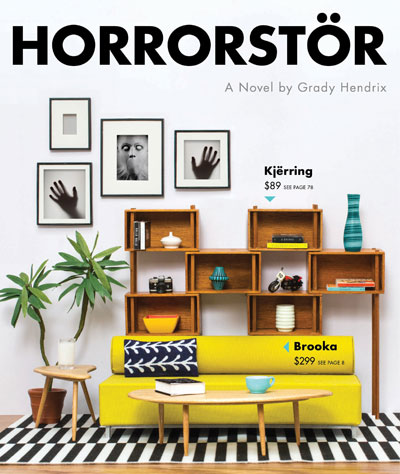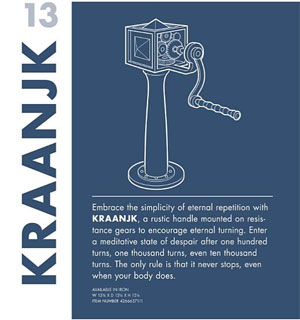Retail Hell
Horrorstör by Grady Hendrix
I love a classic haunted house as much as anyone. There’s something wonderful about an old abandoned house (or mansion or castle or hotel or insane asylum), dilapidated, decaying, overgrown, crumbling, filled with creaking doors, dark shadows, creepy dolls, and something sinister that whispers from the attic.
But there’s also a place in my heart for a modern, clean, brightly-lit building that’s nevertheless crawling with the unquiet spirits of the dead. The suburban home built over an Indian graveyard, the supermarket with bloody handprints appearing mysteriously on the freezer cases, the trendy nightclub plagued by unusual deaths and fashionable vampires. Horror writers love this stuff, too — you can find horror wrapped around modern suburban and retail settings in films like “Poltergeist” and “Dawn of the Dead” (and many other early-outbreak zombie movies) and in books and stories like Stephen King’s “The Mist,” Anne Rivers Siddons’ “The House Next Door,” and Mark Z. Danielewski’s “House of Leaves.”
And now there’s also this book, “Horrorstör,” a short horror novel (with strong humor elements) written by Grady Hendrix and published a few months ago. Its focus is on a haunting at an IKEA-style big box retail store.
The lead character in the story is Amy, a slacker in a thoroughly dead-end job working retail at ORSK, a furniture and housewares store designed from the ground up to look and feel like an IKEA store. It has the same winding pathway through the store, the same “Magic Tool” required to put every piece of furniture together, the same style of faux-Scandinavian names for all the products. Amy wants to transfer back to the ORSK store she used to work at, mainly because she thinks she’s about to get fired by Basil, an assistant manager and gung-ho ORSK fanboy. But as it turns out, Basil actually wants to ask Amy and another co-worker, Ruth Anne, an older long-term employee who lives for her job, loves stuffed animals, and is adored by everyone on the staff, to take on a special duty — patrolling the store at night.
You see, the store has been suffering unusual vandalism. Some of the glassware has been broken, furniture has been soiled, and there are odd smells in the building. Basil wants Amy and Ruth Anne to join him on a secret late-night patrol, after everyone has gone home, to see if anyone is breaking into the building. They soon find some interesting problems. There are rats in the kitchen showcases, even though there’s no food there and no water hookups. Everyone keeps getting lost, which might make sense if they were just customers and not employees trained to find their way around the store quickly. And the mysterious grafitti messages in the restrooms referring ominously to “the Beehive” are multiplying rapidly.
And they do find some unexpected interlopers. Matt and Trinity are a couple of fellow co-workers at ORSK who have sneaked into the store because Trinity thinks there are ghosts in the building and wants to start a career as a reality-TV ghost hunter — and Matt is there because he’s got a lot of camera equipment and wants to get into Trinity’s pants. And there’s also a homeless man, Carl, who has been secretly living in the store for a few weeks.
So Carl is obviously the vandal, right? He’s in the store all night, frustrated by his low position in society, maybe he goes and craps on the occasional sofa and busts up a cabinet, you know? But no, Carl insists he’s not the culprit, and he doesn’t seem to be a particularly malicious guy. So what’s going on?
Trinity has an idea. She still thinks there are ghosts in the building, and what’s the best way to contact ghosts? Let’s everyone hold a seance!
And how do they keep the circle intact, to keep everyone connected and to create an interesting visual for the tape Trinity and Matt want to shop to cable TV?
They use handcuffs.
And then everything goes straight to hell.
Because the ORSK store wasn’t built over an Indian burial ground. It was built on the site of an ancient, notorious prison, run by Josiah Worth, a warden obsessed with his personal punishment fetish, believing that the way to turn the wicked to goodness was to torture them, no matter how minor their offense, to keep torturing them past the span of their sentence, and ultimately to torture them forever.
And Worth now has a foothold back into the corporeal world so he can use his own eerie abilities, his other-dimensional dungeon, and his army of tortured, mind-crushed minions to bring the miracles of his prison, his beloved Beehive, to the hapless wage slaves of ORSK.
Can Amy and her coworkers survive the night shift at ORSK? Can they escape the store? Or are they doomed to toil forever in the stone walls and iron restraints of the Beehive?
Verdict: Thumbs up. I really enjoyed this book. I burned my way through it as quickly as I could, and a couple nights, where I made the mistake of reading it too close to bedtime, it actually kept me up late. I did think that the very best parts of the novel were fairly early on, when the scares were subtle and more creepy than heart-stopping. The seasoned employees getting lost in their own store? That was weirdly realistic — you could imagine it happening, but you could also see why it would be really unnerving. The odd sounds after the store closes, combined with the sudden unfamiliarity of the environment of the store was also spooky — and definitely familiar for anyone who’s ever had to work late in their office, where darkness and emptiness make the comfortable surroundings feel strange and dangerous.
Even better than that was the graffiti in the restroom. The dozens of scrawled names and scratched-out years, all referencing the mysterious Beehive, feel intensely eerie, a perfect element to place in a modern retail ghost story. There are also some very effective moments when the employees discover that the purely decorative doors in the showcases now open into dank, cavernous hallways leading deep into the earth.
And everyone getting handcuffed together for the seance? That may have been a monumentally stupid move on the part of the characters, but it’s an original and wonderful thing to have in a horror novel. It’s simultaneously terrifying — because you know what’s going to happen — and hilarious — because you know what’s going to happen.
Once Worth makes his appearance, and especially when he captures Amy for the first time, the story starts moving away from being a ghost story and edging more into torture porn. The story shows some serious cracks in this section, in part because it’s too long — I just don’t enjoy reading multiple pages about someone being strapped into a torture chair that tightens to the point where she loses sensation in her limbs and can barely draw a breath. (This may also indicate that I have never enjoyed torture porn.) But it’s also a bit too short — we’re told that Amy’s mind breaks almost entirely not long after she’s strapped in, to the point where Stockholm Syndrome sets in and she starts worshipping Josiah Worth. And then, when she’s released from confinement, it’s not too many more pages before her mind has completely recovered to its previously healthy state — and even improved, as she’s much braver and more resourceful for the rest of the novel.
The characters are mostly well-done, interesting, and charismatic — but we never even find out what happened to two of them at the end of the novel. It may be more realistic — when the Hellmouth opens up underneath you, you may end up losing track of some of your coworkers in the chaos and never see them again — but it still feels like the story is unfinished because of the lack of closure.
It must be said, though, that one of the real selling points of this novel is the fantastic graphic design by Andie Reid and illustrations by Michael Rogalski. The book cover looks like one of the big, glossy IKEA design catalogs — with a few subtle and not-so-subtle differences to give some visual cues to the horrors within — and each chapter opens with a page from the fictional ORSK catalog spotlighting one of their products, complete with IKEA-style art, a faux-Scandinavian name, and upbeat flavor text. But after the supernatural terrors start climbing out of the woodwork after the seance, all the featured furniture gets replaced with medieval torture devices. It makes the story a lot more fun and a lot funnier, while still giving a nice dose of the chills to readers.
All in all, it was pretty fun. Go pick it up.
Comments off


